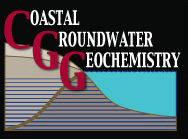ARION - The Arctic Radium Isotope Observing Network
Quantifying Seasonal and Interannual Changes in Shelf-Derived Material Inputs to the Arctic Ocean
Within the Arctic Circle, rapidly rising air and sea temperatures have resulted in the loss of sea ice, increased river discharge, coastal erosion, and permafrost thaw. Many of these changes are adding nutrients and carbon to the shallow seas that surround the Arctic Ocean, specifically by increasing interactions with sediments on the land or those over the continental shelf. Importantly, the resulting changes are not limited to the coastal seas: added nutrients and carbon can be transported to the central Arctic Ocean via strong surface currents. Climate-related changes in Arctic Ocean chemistry may therefore influence primary production across the Arctic, and ultimately affect the amount of nutrients reaching the North Atlantic via Arctic outflow. This project will fill an important research gap by monitoring interannual and seasonal changes in radium isotopes as proxies for chemical inputs to the Arctic Ocean that are sourced in sediments, with a focus on the transfer of elements from the shelf seas to the central Arctic.
Radium isotopes are continuously produced at ocean boundaries and are soluble in seawater. Radium therefore serves as an analogue for similarly sourced shelf-derived materials, including biologically important elements such as carbon, nutrients, and trace metals. To test the hypothesis that climate change is leading to increased delivery of terrestrially-derived solutes to the Arctic Ocean, radium levels will be measured on bi-annual cruises along the Laptev and East Siberian Sea margins (to capture interannual changes) and on a first-of-its kind in situ radium isotope sampler (to capture seasonal changes). These sampling efforts will be complemented by an international network of collaborators that will contribute data to create an Arctic Radium Isotope Observing Network (ARION) that spans the Arctic Ocean and will serve the greater scientific community. The project will also partner with an artist-explorer to communicate the importance of this research to the general public through exhibitions at a local museum.
Proposed Research
This project will include combined shipboard and mooring-based observational network for measuring radium isotopes in the Arctic Ocean. The observational network (ARION) will leverage an existing NSF-AON program (Switchgear) that includes bi-annual cruises from which we will collect spatially distributed water column samples and a series of mooring arrays from which we will deploy a first-of-its-kind in situ radium isotope sampler.
Seagoing sampling: Water column sampling along the Switchgear program route will consist of multiple shelf-slope transects extending from Eurasian Basin to the Makarov and Amundsen Basins. This will enable understanding of transformations that occur along the shelf-basing pathway. In addition, along-shelf sampling will help identify the area where the transpolar drift leaves the Eurasian shelves.
Moored time series: Radium and water isotope samples will be collected monthly at two key locations with respect to shelf-basin exchange in the eastern Arctic: one offshore of the East Siberian Shelf and another close to the Laptev Sea shelf-break. The novel Ra isotope sampler will be modified versiton of the McLane Laboratories Phytoplankton Sampler. Working with McLean Labs we will extend the sampler life and capacity to process 50L/sample and be deployed for up to two years.
Find more information on the ARION project website.
Collaborators
- Lauren Kipp (co-PI) Department of Environmental Science at Rowan University
- Paul Henderson - Research Specialist WHOI
- Walter Geibert - Alfred Wegener Institute, Germany
- Guangquan Chen - First Institute of Oceanography, China
- Diane Burko - artist/explorer
More information
- Check out the ARION website to find out more about the project goals, sampling plan, and outreach
- Project news and associated publications are also posted on the ARION website

